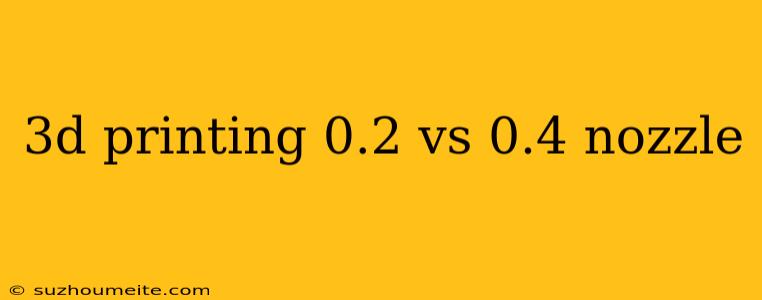3D Printing: 0.2 vs 0.4 Nozzle - Which One to Choose?
When it comes to 3D printing, the nozzle size is one of the most crucial factors that can affect the quality and precision of your prints. Among the various nozzle sizes available, 0.2 and 0.4 are two of the most popular ones used in FFF/FDM 3D printing. But, which one is better? In this article, we'll dive into the details of both nozzle sizes, their characteristics, and help you decide which one to choose for your 3D printing projects.
What is a 3D Printing Nozzle?
Before we dive into the comparison, let's quickly understand what a 3D printing nozzle is. A nozzle is the metal tip at the end of the 3D printer's extruder that dispenses the melted filament onto the build plate. The nozzle size determines the thickness of the extruded filament, which directly affects the layer height, resolution, and overall print quality.
0.2 Nozzle
Pros:
- Higher Resolution: With a smaller nozzle size, you can achieve higher resolution prints with more detailed layers.
- Smaller Layers: 0.2 nozzles can produce layers as thin as 0.05 mm, making them ideal for printing small, intricate models.
- Less Material Wastage: Smaller nozzles require less material to achieve the same layer height, resulting in cost savings.
Cons:
- Slower Print Speeds: To achieve high-quality prints, you'll need to reduce the print speed, which can lead to longer print times.
- Clogging Issues: Smaller nozzles are more prone to clogging due to their narrow passageway.
- Less Suitable for Large Prints: 0.2 nozzles are not ideal for large prints, as they may struggle to maintain a consistent flow rate.
0.4 Nozzle
Pros:
- Faster Print Speeds: With a larger nozzle size, you can print faster without sacrificing quality.
- Less Clogging Issues: Larger nozzles have a wider passageway, reducing the likelihood of clogs and making maintenance easier.
- Better for Large Prints: 0.4 nozzles are well-suited for printing large models, as they can maintain a consistent flow rate.
Cons:
- Lower Resolution: Larger nozzles result in thicker layers, which can affect the overall print quality and detail.
- More Material Wastage: Larger nozzles require more material to achieve the same layer height, increasing costs.
When to Choose 0.2 Nozzle:
- Small, intricate models: If you're printing small, detailed models, such as miniatures or jewelry, a 0.2 nozzle is the better choice.
- High-resolution prints: If you need to achieve extremely high-resolution prints, a 0.2 nozzle is the way to go.
When to Choose 0.4 Nozzle:
- Large prints: If you're printing large models, such as prototypes or functional parts, a 0.4 nozzle is a better option.
- Fast print speeds: If you need to print quickly without sacrificing quality, a 0.4 nozzle is a good choice.
Conclusion
In conclusion, the choice between a 0.2 and 0.4 nozzle ultimately depends on your specific printing needs and preferences. If you prioritize high-resolution prints and don't mind slower print speeds, a 0.2 nozzle is the way to go. However, if you need to print large models quickly and efficiently, a 0.4 nozzle is the better choice.
